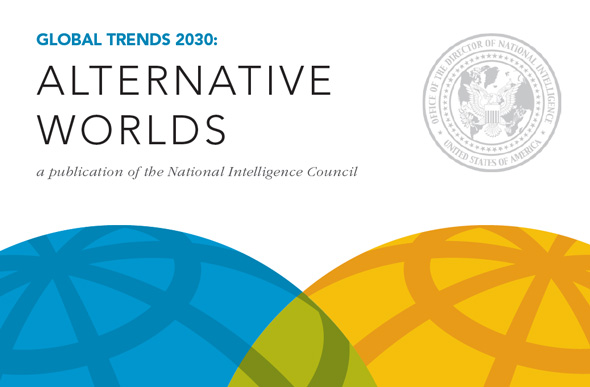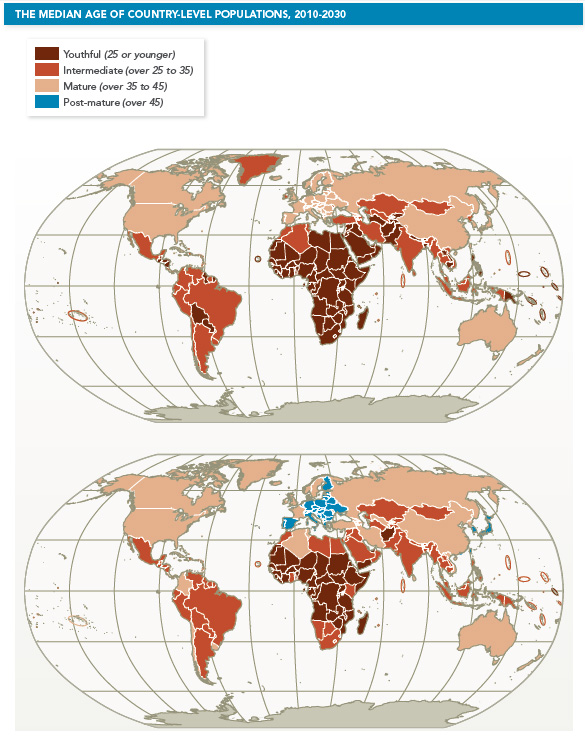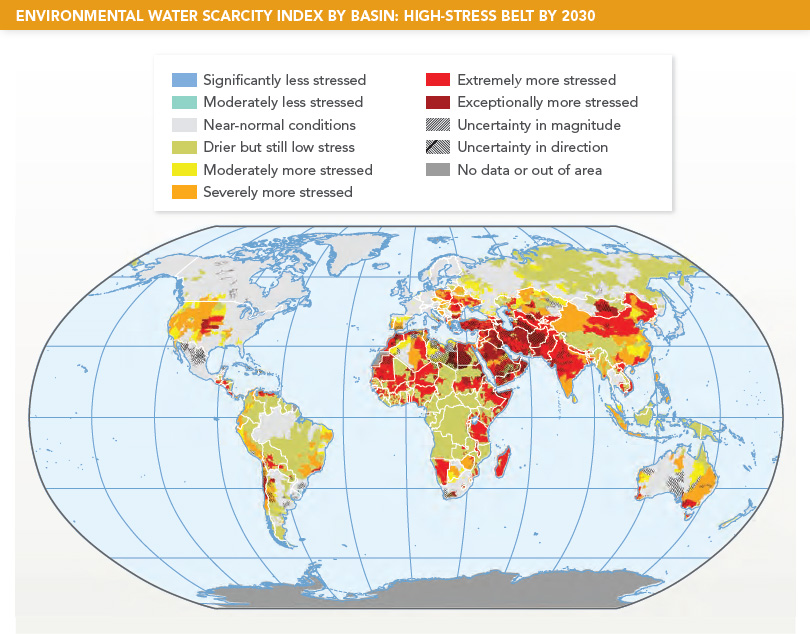-
National Intelligence Council Releases ‘Global Trends 2030’: Prominent Roles Predicted for Demographic and Environmental Trends

“We are at a critical juncture in human history, which could lead to widely contrasting futures,” writes the chairman of the National Intelligence Council (NIC) Christopher Kojm in the council’s latest forward-looking quadrennial report, Global Trends 2030: Alternative Worlds, released yesterday.
This year, principal author Mathew Burrows and his colleagues focus on a series of plausible global scenarios for the next 20 years and the trends or disruptions that may influence which play out. Among the most important factors in these projections are demography and the environment.
“We are at a critical juncture in human history”According to the NIC, by 2030, no country is likely to be a globally hegemonic power and four “megatrends” will have shaped international relations: accelerated individual empowerment; diffused power among and within countries; novel and diverging demographic patterns; and growing natural resource demand (food, water, and energy).
Many of today’s most fragile states – including Afghanistan, the Democratic Republic of Congo, and Somalia – are likely to remain so for the next 15 to 20 years, with demographic and environmental challenges playing a prominent role. Meanwhile rising powers will likely continue their ascent, and many traditional powers will face relative decline.
Four Demographic Trends
The NIC’s treatment of demography identifies four trends that its authors argue will substantially influence the future of international relations – to 2030 and beyond:
- Aging, which they call “a tectonic shift” for developed countries but also increasingly many developing;
- Youthful Societies and States, which they note is a shrinking but still-significant number;
- Migration, which is expected to be more cross-border and increasingly common; and
- Urbanization, which is a continued trend that will accelerate and take center stage as its side-effects impact Africa and parts of Asia.
Changing Age Structures
 By 2030, nearly all of Europe, South Korea, Japan, and Taiwan will have a median age of 45 or older, compared to just Japan and Germany today. This “pensioner bulge” will create labor and health system challenges and has also been cause for concern for some national security watchers. But the NIC points out that these predictions are “speculative,” since the trend is unprecedented and advances in healthcare may play a mitigating role.
By 2030, nearly all of Europe, South Korea, Japan, and Taiwan will have a median age of 45 or older, compared to just Japan and Germany today. This “pensioner bulge” will create labor and health system challenges and has also been cause for concern for some national security watchers. But the NIC points out that these predictions are “speculative,” since the trend is unprecedented and advances in healthcare may play a mitigating role.On the flip side, the NIC expects the number of countries with very young age structures to contract from some 80 countries today down to 50. The “demographic arc of instability” – a group of countries from South Asia to southern Africa with very young age structures and higher incidences of conflict and instability – will also shrink. The equatorial belt of sub-Saharan Africa will be the largest cluster of persistently high growth-rate countries, followed by a smaller cluster in Middle East, including the Palestinian Territories, Jordan, and Yemen. Bolivia, Guatemala, and Haiti are projected to be the only very youthful countries remaining in the Americas.
Youthful Minorities in Aging Countries
For Asia, using the U.S. Census Bureau’s projections, only Afghanistan is projected to remain youthful by 2030. “However,” the authors note, “the aging that will occur among the large and growing populations in nearby Pakistan and India probably will mask youthful ethnic and regional populations that could remain a security concern.”
These pockets of youthful minorities may continue to cause instability in places. Tribal populations in Pakistan’s west, for example, are expected to remain youthful for most of the next two decades. And in India, fertility rates are likely to remain higher in the provinces of Uttar Pradesh and Bihar than the rest of the country, which could exacerbate instability, like the country’s ongoing Maoist insurgency which has human development and natural resource drivers and has affected Bihar very strongly.
Crucial Demographic Dividends
For those countries transitioning from very young to intermediate age structures, achieving the economic bonuses of the “demographic dividend” will be crucial, the NIC reports.
Nigeria, Africa’s most populous country, is used as an example. The authors point out that if it “collects on its demographic dividend in full, it could see per capita incomes treble by 2030, lifting 80 million people out of poverty.”
Richard Cincotta on the relationship between demography and democracy But as Elizabeth Leahy Madsen has pointed out on New Security Beat, collecting the demographic dividend is not automatic. In particular, educating and empowering young women and better health infrastructure are very important prerequisites which Nigeria and many other fast-growing countries in sub-Saharan Africa and the Middle East have so far not achieved.
Whether or not Nigeria takes advantage of the demographic dividend, migration will be another population dynamic at play. If the prerequisites for the dividend are not achieved or the population continues growing at a rapid pace, the NIC suggests strife and economic underperformance could create substantial incentives to migrate elsewhere. On the other hand, if the dividend is achieved, Nigerians abroad may return home in large numbers to participate in the economic success.
The take-way is that migration will “become more globalized” as the drivers for internal and cross-border movement intensify, including urbanization, disparate age structures, existing migrant networks, climate change, and the “specter of greater economic opportunity.”
Urbanization on a Staggering Scale
Urbanization will largely be the continuation of an existing trend, but will have carry-on effects for the regions changing the most. Sub-Saharan Africa and Asia are the regions with continued population growth and relatively low proportions of existing city-dwellers and therefore will see the fastest rates of change. China and India alone will need to accommodate 276 million and 218 million additional people living in cities between now and 2030.
These changes are expected to drive more “urban-centered economic growth,” smaller family sizes, and higher levels of education, among other changes. But there will also be attendant environmental and resource challenges.
The scale of expected changes is staggering: Over the next 40 years, the authors write, “the volume of urban construction for housing, office space, and transport services…could roughly equal the entire volume of such construction to date in world history.”
Resource Constraints, Conflict Potential
Natural resource constraints – especially when layered on top of demographic trends and other environmental stresses – are expected to increase uncertainty and instability worldwide, the NIC concludes.
In sub-Saharan Africa, South Asia, and the Middle East, where water and land shortages will often coincide with “disproportionate levels of young men,” the report warns of an increased risk of intrastate conflict.
In the discussion of natural resources and the potential for conflict, the focus is often on oil, water, or minerals. In this case, however, the NIC saves its gravest warning for an often-overlooked resource: soil.
The authors classify the erosion and depletion of soil as “a natural disaster that might cause governments to collapse,” alongside threats like drought or crop infestations, tsunamis, and solar storms. The problem of soil depletion has been a long time in building: “Worldwide soil erosion has caused farmers to abandon 430 million hectares of arable land since the Second World War, an area the size of India,” they note.
To avoid a future of scarcity policymakers and the private sector “will need to be proactive” to apply technological advances and public policy in a manner that avoids exacerbating resource constraints. That will be a complex task, since “tackling problems pertaining to one commodity won’t be possible without affecting supply and demand for the others,” and the NIC predicts “many countries probably won’t have the wherewithal to avoid food and water shortages without massive help from outside.”
Aside from shortages, traditional national resource dynamics may be upended as well. The NIC points out that, depending on the degree of development, shale gas development has the potential to make the United States energy independent and upend the power of OPEC, with potentially grave economic and social consequences for traditionally-oil dependent economies.
Stacy VanDeveer on petro-state stability and oil consumption Climate change too will contribute to resource management challenges, as the observed extreme weather events of today, from floods to droughts “almost certainly will continue during the next 20 years.” Furthermore, what happens over the next 20 years will likely determine what happens over the next 80 since, by 2030, the world’s “emissions trajectory will be cast, determining this century’s climate outcome.”
Overall, over the next 18 years, the report cautions that “there is as much scope for negative tradeoffs as there is the potential for positive synergies” in the environmental sector.
“A Critical Juncture”
Though they note the purpose of the report is not to predict the future but to “provide a framework for thinking about possible futures and their implications,” the NIC nevertheless concludes that “the world of 2030 will be radically transformed from our world today.”
Population dynamics, climate change, and natural resource management are long-term, difficult-to-understand trends so its perhaps not surprising that they are strong actors in the NIC’s scenarios.
“We hope this report stimulates dialogue on the challenges that will confront the global community during the next 15-20 years – and positive and peaceful ways to meet them,” the authors conclude.
“The world of 2030 will be radically transformed from our world today”To that end, Global Trends 2030 has been more public and collaborative than previous editions. The NIC specifically sought out international and non-government viewpoints during the writing process and started a blog for discussion of key themes, which has posted more than 140 stories so far from contributors and non-contributors alike (see here for a run-down of the population aging series, curated by ECSP consultant and Global Trends contributor Richard Cincotta, for example). The council’s Twitter account too has been active with continuous discussion about the report and its themes.
“Global Trends 2030 is not your father’s intelligence community assessment,” says Ohio University professor and ECSP senior advisor Geoff Dabelko. “The authors recognize that the best understanding of interdependent trends cannot be gained from merely the world of secrets. Making sense of the complexity facing the world today requires skill sets and perspectives outside the government and outside the United States.”
“It is our contention that the future is not set in stone, but is malleable, the result of an interplay among megatrends, game-changers and, above all, human agency,” writes Kojm. “Our effort is to encourage decisionmakers – whether in government or outside – to think and plan for the long term so that negative futures do not occur and positive ones have a better chance of unfolding.”
Sources: National Intelligence Council, U.S. Census Bureau.
Image and Charts Credit: Global Trends 2030/National Intelligence Council.
 A Publication of the Stimson Center.
A Publication of the Stimson Center.





